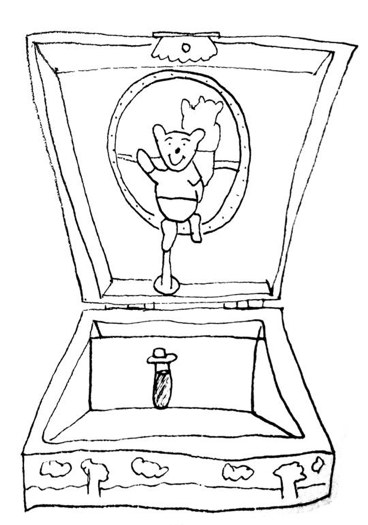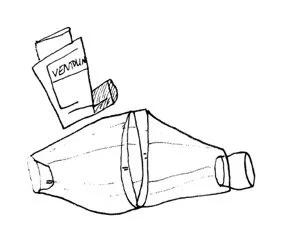Objects of Illness/Recovery – by Anna Jacobson and Katerina Bryant
ISLAND | ONLINE ONLYAn Alternating Collaborative Essay
As rainwater seeped through the laminate flooring, I piled my objects onto my bed: an antique out-of-tune zither, my books, a woven rainbow rug that had made my room my home. I lost none of these objects, but I did lose my shelving, which drank up water through its base. I also lost my room at the rental that had housed all my things – the doorway warped with water damage and was no longer safe to inhabit. I stayed with a friend for two-and-a-half weeks while I tried to find a new place to live. My objects were splayed across three different suburbs, and I felt fractured: one part at the old share house – safe if the disintegrating ship of the bed could hold – another part in a suitcase at a friend’s house, and a third split lifeline to my parents’ home. I wore my hamsa ring – silver hand with larimar stone at its centre – to ward off the evil eye. I needed spiritual protection, wanted to feel safe.
I placed a shell box on the bedside table in my friend’s spare room. The top had faded from one ocean hue to another from the tracking sun: Caribbean to emerald. This box hid all my meds in their blister pack, a pill cutter, a dragonfly pill box. The tiny studio I managed to get a lease for wouldn’t fit any of my objects. It didn’t have room for a bookshelf or bedside table, so I stored five books on a single pantry shelf, my shell box on top. Furnishings and practical vessels would now become my world: my doona cover with its colourful flowering cacti design, my ceramic fruit bowl glazed with the leaves of a plum tree, my purple kettle. I could not bear to part with my other belongings, so I stored my life in boxes at my parents’ home, in my old room.
Dad decides to clean the storage unit; he fills his car with plastic tubs, and I drag them into his house. Mum and I realise the boxes haven’t been touched for almost twenty years. I expect to find old toys but instead I’m met with a time capsule of the ordinary: worn sneakers, Roxy tee shirts and board shorts printed with hibiscus. Mum thinks it’s a mistake that we kept these things. We must have mixed up the boxes meant for the bin. But I doubt it; I remember how I was as a child. So fixed on objects, unable to throw them away. I would hold on to slips of paper, broken plastic. I once tried to trace this obsession to illness. Was this part of my OCD? But I’ve since given up this questioning; there’s no use in tracking through the past with a medical magnifying glass.
In one box, I find a Winnie the Pooh jewellery box. It’s musical and when opened, Winnie spins, his outline reflected in a silver plastic mirror. The box is empty, except for a tube of fake blood. I laugh, knowing that this would have been precious to me. I’ve always been drawn to the macabre. In another box, I find clothes. Worn fabric, heavy with memory. I take the stack of clothes home, wash them, try them on. I find, with surprise, clothes I wore at ten still fit. It’s a shock but not wholly unexpected. I’ve been more unwell than usual this past year and, for the first time in my life, unintentionally lost a lot of weight. I put on a Big W denim miniskirt with lace edging and a leather cord tie. It scares me how easily I can slip into my child-self; how illness made this possible.
I had long dispersed of my rattling spaceship asthma spacer and the blue nebuliser machine from my childhood. I hated that nebuliser and mask; the droplets of moisture that clung to my face underneath it as I inhaled the muggy vials of medicine like a science experiment. Throwing out these objects felt good. I didn’t want them in my sight ever again. I still carry Ventolin in my bag just in case but haven’t needed it in years. My asthma flared on day two of isolation. I had managed to avoid Covid until the third wave, and now slept with my Ventolin inhaler on the pillow next to me. In the morning, the pharmacist in my street delivered a preventative inhaler to my door that my GP had recommended. But I couldn’t twist the lid off the device, either anticlockwise or clockwise. I felt weak. I tried for five full minutes, stopping only when a blood blister bloomed between my thumb and pointer finger.
I needed to take the medicine – it was in my hands, and I couldn’t access it. I had never felt so helpless and on my own. I called the chemist who asked me if I had trouble opening jars. I had once bruised my hands trying to open a jar of salsa. Turn the inhaler upside down and twist so you have a better grip. We’ll stay on the phone with you, we’ll be here the whole way. Finally, the lid gave way. The chemist cheered and I heard the counter staff clapping. I hung up, used the inhaler, and had an allergic reaction. My breathing worsened, and I needed to use Ventolin again. The lid hadn’t wanted to come off the inhaler for a reason. My body was rebelling against the asthma medication. My body didn’t want to be that ill child again.
If you asked, I would say I wasn’t a sick kid. In my story, illness came – heavy and thick – when I was a teenager. At fifteen, I spent three months in bed. One illness coming after another. I remember loading SVU DVDs into a chunky laptop. Time slowed, measured by discs. Around that time, a friend called me on my Nokia. I had a bad fever, and my words didn’t make sense. Later, she asked if I remembered what I said; I didn’t remember that she’d called.
Now, approaching my thirties, I realise that this story I’ve built for myself isn’t quite right. Illness goes back as far as my memories do. At seven, I synced my breaths with the counting that repeated in my mind. I was terrified; if I fell out of rhythm, something horrible would happen. I would go to bed, padding around the house in dog-print pyjamas and checking all the light switches. Once, and then again. In case my mind was playing tricks.
I remember thinking this was the way everyone’s mind worked, but I wonder if – even then, so young – I was lying to myself. I hid rituals, kept thoughts unspoken. Secrecy felt natural. Perhaps I knew I couldn’t be understood.
I couldn’t be understood by others, but my unconscious mind knows me too well – my dreaming mind. When I am ill, my dreams take me on massive quests. Sometimes I feel better on waking, as though my body has found a way to repair through the night. Sometimes objects are given to me in dreams: pieces from Escher-like staircases, balustrades crumbling in my hands. After this dream, I wake with my hands clenched and sore, and need to move them to get rid of the stiffness. I am in my thirties and beginning to feel pain. I don’t want to tune in to my body or I will feel more pain. In another dream I am standing on the foundation stone of a house made from paddle-pop sticks. The walls are lifting; the house is empty. I am still living in the tiny studio I found during the floods, my belongings at my parents’ home. I want to be surrounded by my things again. But nothing will fit.
I dream I’m in high school, walking the same path from lockers to class, class to lockers. It’s not an uncommon dream for me, and lately there’s a new addition: I am told that I didn’t actually graduate and must go back and do it all again. From this I wake, sometimes damp, and think about the power of objects and place. I remember the thick blue carpet of the English classroom. The toilet cubicles where I once closed the door so hard that I broke it and locked myself in. I couldn’t bring myself to crawl under the door. Maintenance had to be called.
It takes months to realise I’m dreaming of a place that no longer exists. Of folders and plastic slips that were long ago abandoned to landfill. That part of the school has since been renovated. It’s not the only place that exists in my dreams. In sleep, I go back to my yiayia’s home. Now demolished but while I’m asleep it’s as it once was. I see the daisy bush, covered in bees. The garden is unchanged, and I listen to the windchimes, bright in the afternoon breeze.
Objects and places hold strong memories. When I’m well, the kitchen is where I can be creative. I buy a cooking pot at Lifeline to boil pasta for one. There’s something about its shape and size that I like. At this Lifeline shop, there’s a whole kitchen section with everything from jar openers to egg slicers. I buy the jar opener for $2. When I am well, I cook and bake. My current rental doesn’t have an oven and the one hotplate that works is temperamental. But still I manage to make kimchi fried rice with egg and coriander. Cooking is a sign I am well and have energy again. I can sense when the oil is hot enough, give the ingredients my care. I choose my own patterned tea towels, serve my food in painted bowls bought long ago from Target or Kmart.
When I got out of a psychiatric hospital in 2011, after psychosis, the first thing I made at my parents’ home was potato gnocchi from scratch. When I got out of a psychiatric hospital in 2020, after an antidepressant changeover, the only thing I could manage to put together was a peanut butter and banana sandwich. Meds can make me very unwell, and I have had adverse reactions to the majority I’ve been prescribed. Some have nearly killed me. Food is different. Often, it’s one of my only joys. A well-seasoned dish filled with flavour and good ingredients can make me cry with the first few bites.
When I can’t sleep, I imagine myself entering my home. I open the door and list each object I see. A wooden chair with woven leather seat. A bargain from a store I drove past after a haircut. A framed watercolour from Vinnies. Coat hooks bought on Facebook Marketplace. In my mind, I form the objects I see every day. The act of imagining them and where they’ve come from – now united in my home – is peacefully mundane. I move through the house, checking off each item, until sleep comes.
Before the pandemic, at night I would visualise packing a bag for a trip. My hands would fold clothes into perfect squares. I would leave with not too much, nor too little. For years, I fell asleep to the idea of being perfectly prepared. Not until writing this do I realise the peace I find is in the presence of objects. It’s a flimsy calm; things break, are repaired, or ruined. Yet, there’s something about objects that settles me. This feeling comes, too, when walking through a museum or op shop. Perhaps it’s the calm that comes from looking. When I focus on what is in front of me, I am taken away from what is felt within my body. ▼
© Illustrations by Anna Jacobson









